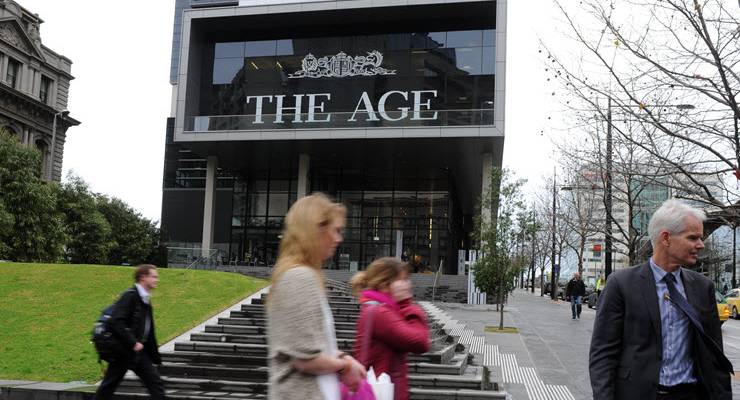
The fight for a journalism that serves its local communities has spilled into metropolitan mastheads with the revitalised call by The Age journalists for the masthead’s independence, together with last week’s announcement by News Corp that reporting in its metro tabloids would be “done once … and shared across the company”.
A letter to Nine management signed by about 70 The Age journalists revealed deep internal concerns about “politicisation” of the masthead, a failure to reflect the diversity of Melbourne and complaints about the paper becoming a Sydney subsidiary.
The letter, revealed over the weekend in competing “exclusives” from The Guardian and The Australian, is the most serious revolt by the company’s journalists over editorial independence since the Nine takeover last year.
Nine is chaired by former Liberal Party treasurer Peter Costello. Its CEO Hugh Marks hosted Morrison at a $10,000 a head Liberal Party fund-raiser on company premises last year. The executive editor of the Sydney and Melbourne mastheads, James Chessell, is a former staffer of another former Liberal treasurer and current Sky News contributor, Joe Hockey.
At a surface level, The Age letter is the Australian equivalent of the ongoing US newsroom revolt over how to report systemic racism. It bounces off an Age editorial that claimed, “Australia does not have a legacy of slavery”, published in the days before the similar Morrison gaffe. The editorial was only corrected after the staff letter was received.
The immediate trigger was an unsubstantiated June 5 front page headed, “Activists ‘planning trouble’ at protest”, which relied on a single unidentified source to claim activists were threatening to spit on police in that weekend’s planned march. It was corrected with an apology to march organisers online later that day.
The Age has been concerned about being run from Sydney — about becoming the SMAge — since the-then Fairfax bought 50% of the company in 1966. It sustained its separate management and newsrooms until Fairfax bought out the remaining half in 1983.
Under full ownership, the two papers started sharing copy and resources and year by year, the sharing and editorial control grew. After family control imploded in 1990, the new publicly-traded Fairfax Media ratcheted up the integration of editorial, and around 2000, created a shared editorial management structure which has been further tightened under Nine ownership.
Step by step, this was resisted by journalists at both The Age and The Sydney Morning Herald, resulting in internal balances such as separate bureaus in the Canberra gallery and an agreement to turn-about foreign postings between the two mastheads.
But the collapse of advertising since the 2008 economic crisis has seen the pressure increase.
Since 1988, The Age and The Sydney Morning Herald have been protected in part through charters of editorial independence which empowered editors to make editorial decisions free from corporate pressures. These depend on the editor being prepared to stand up and, over their three decades, the principles of the charter have relied on the journalists for protection — including with strike action.
Similar trends have shaped News Corp’s metropolitan tabloids since the company took over the Melbourne-based Herald & Weekly Times in 1987. Papers once as varied as The Adelaide Advertiser and The Daily Telegraph were increasingly pushed into a common tabloid format and layout with shared copy. Ad-heavy inserts were centralised, with masthead branding often the only difference.
Last week’s announcement by News Corp to shed jobs across the tabloids and centralise all copy marks the final stage in turning separate mastheads into city-based franchises of a corporate template.
But both the history and the concern about reporting Indigenous disadvantage conceal a deeper economic truth: while newspaper chains like Fairfax and News Corp may have strengthened newspapers in the ad-rich capital-intensive days of print, they weaken all mastheads in the more agile digital age.
All the current evidence — from The Boston Globe to the Broken Hill Barrier Daily Truth — shows that independent mastheads rooted in their communities have a stronger business model for survival than the old chains.
Readers don’t buy mastheads to contribute to corporate EBITDA. They buy for the journalism values — including local values. Nine management recognised this when it recently sold its New Zealand mastheads to local management who wanted to invest in journalism. Maybe it’s time to do the same with The Age.
Could local ownership save newspapers? Let us know your thoughts by writing to letters@crikey.com.au. Please include your full name to be considered for publication in Crikey‘s Your Say column.








Crikey is committed to hosting lively discussions. Help us keep the conversation useful, interesting and welcoming. We aim to publish comments quickly in the interest of promoting robust conversation, but we’re a small team and we deploy filters to protect against legal risk. Occasionally your comment may be held up while we review, but we’re working as fast as we can to keep the conversation rolling.
The Crikey comment section is members-only content. Please subscribe to leave a comment.
The Crikey comment section is members-only content. Please login to leave a comment.